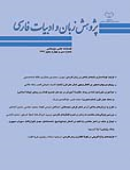سفرهای آیینی اسفندیار در شاهنامه
محورهای موضوعی : پژوهشهای ادبیات کلاسیک ایراننسرین شکیبی ممتاز 1 * , مریم حسینی 2
1 -
2 - دانشگاه الزهرا
کلید واژه: اسفندیار رستم قهرمان فرایند فردانیت تولد دوباره,
چکیده مقاله :
«فرایند فردیت» با مرکزیت حجم قابل توجهی از کهن الگوهای یونگی، یگانگی دو لایة محوری از روان- خوداگاهی و ناخوداگاهی- را درقالب اعمالی نمادین و در طی سفری آیینی برای قهرمان میسر می سازد. در حقیقت، گذر از رویه های مختلف «سایه» و تلاش برای تعدیل نیروی بازدارندة آن، که ریشه در ویژگی های روانی منفی قهرمان دارد، او را در مرحله ای نوین به دیدار «آنیما» مشرّف می سازد. بدین ترتیب، قهرمان با شناخت سویة مادینة روان خود، قابلیت چشمگیری در شناخت «پیر خردمند» که همان حقیقت مانای وجود اوست، پیدا می کند. شناخت جایگاه این پیر که خود یکی از کهن ترین سنخ های باستانی روان آدمی است و نیز عمل کردن به فرامین او، مسیر فردانیت قهرمان را به نتیجه ای می رساند که از ویژگی های روان شناختی مهمی برخوردار است. «تولد دوباره» که در حوزة نمادشناسی آیینی همان شناخت «خویشتن» و یگانگی با آن است، زندگی روانی قهرمان را در الگویی مشخص و پیشبرنده به هدف غایی خود می رساند. در واکاوی روایت زندگی اسفندیار که خود یکی از شخصیتهای محوری شاهنامة فردوسی است، با گذر از روساخت حماسی داستان می توان به ژرف ساختی روان شناختی دست یافت که گویای سیر قهرمان برای رسیدن به هدفی خاص از منظر فرایند شناخت خویشتن، یعنی سفر برای کشف فردانیت است. به این ترتیب، وی با گذر از «هفت خوان» که هفت مرحلة گذر از سایه تلقی می شود، به نجات خواهران از بند ارجاسب تورانی و نابودی او نایل شده و با موفقیت در چنین مراحلی، در سفر بعدی آمادگی مواجهه با رستم را به عنوان پیر خرد پیدا می کند. او در مراحل پایانی فرایند فردانیت خویش و با از دست دادن چشمان ظاهر، حقانیت پیر خردمند را دریافته و با مرگی آیینی، تولدی دوباره می یابد. نوزایی اسفندیار با سپردن فرزند خود، بهمن، به دست رستم جنبه های نمادین و آیینی خاصی دارد.
“The process of individuality” with centrality of considerable amount of Jungian archetypes makes the double-based unification of psyche - self awareness and non-self awareness – possible in the frame of symbolic acts and along the ceremonial journey for the hero. In fact, by passing the different layers of “shade” and attempting to modify its deterrent force which has roots in the negative psyche features of hero, he is in a new step visiting “anima”; therefore, knowing his feminine direction of his psyche, hero achieves great capability in knowing “wise old” who is the real durable truth of existence. Knowing the status of this wise old, which he himself is one of the most archaic kind of ancient human psyche, and obeying his decrees passes the path of individuality of hero to a conclusion which has significant psychological features. “Rebirth” which is equal to knowing “self” and integrating with it in ceremonial symbology, carries hero’s psychological life in a determined and advancing sample toward its ultimate goal. In excavation of narrative of Esfandiyar’s life who is one the main characteristics of Ferdowsi’ Shah-Name, we can come into the psychological deep structure of story by passing the epic surface structure which shows the hero’s journey to reach a special goal from the aspect of knowing self, meaning to discover individuality; therefore, passing “seven steps” which are regarded as the seven steps of passing shade, hero can kill Arjasb Tourani and saved his sisters and achieving victory in this step, he gets ready in next journey to combat with Rustam as the wise old. In the last step of his individuality and losing his eyes, understands the right of old wise and with a ceremonial death achieves a rebirth. Esfandiyar’s rebirth has symbolic and ceremonial aspects depositing his son – Bahman.

